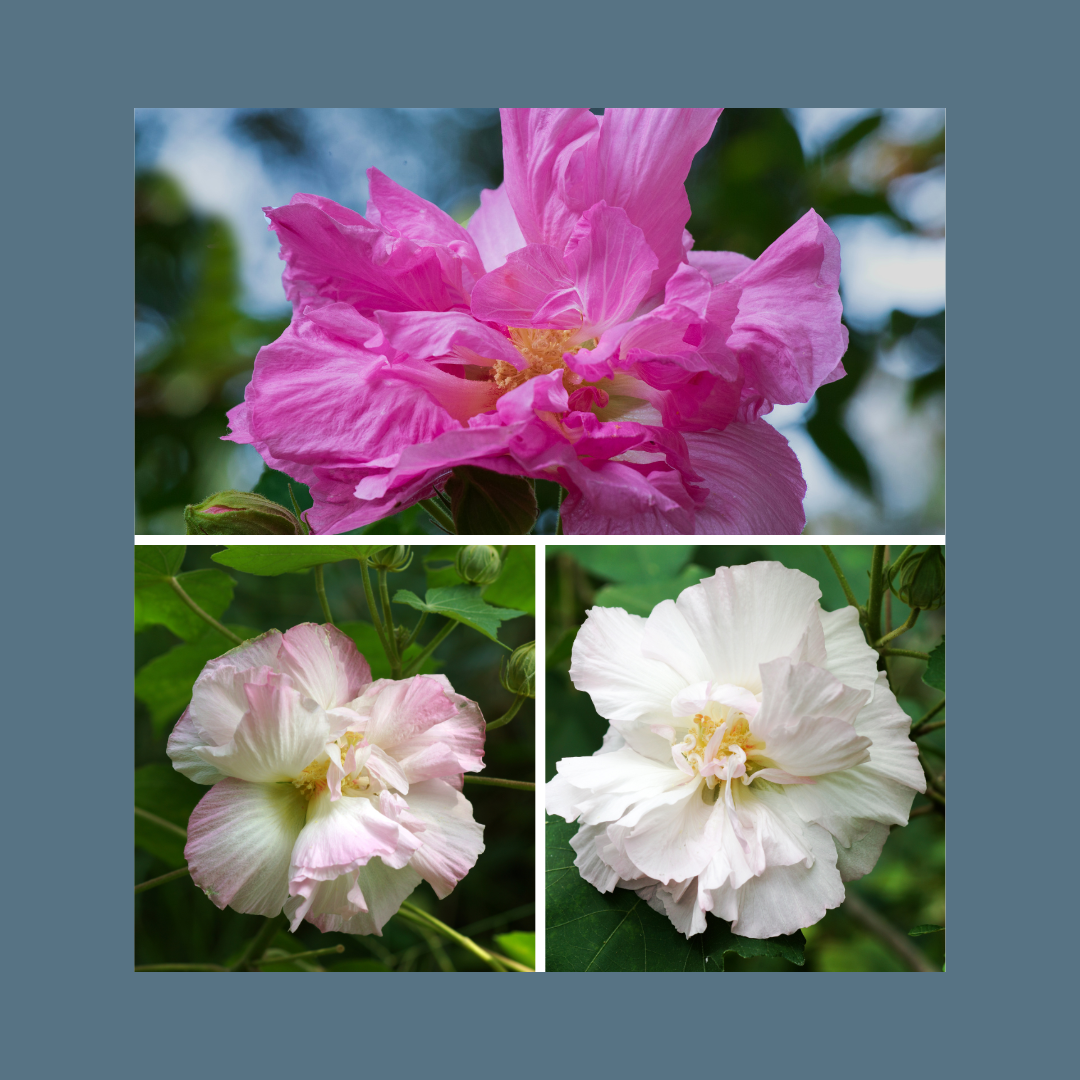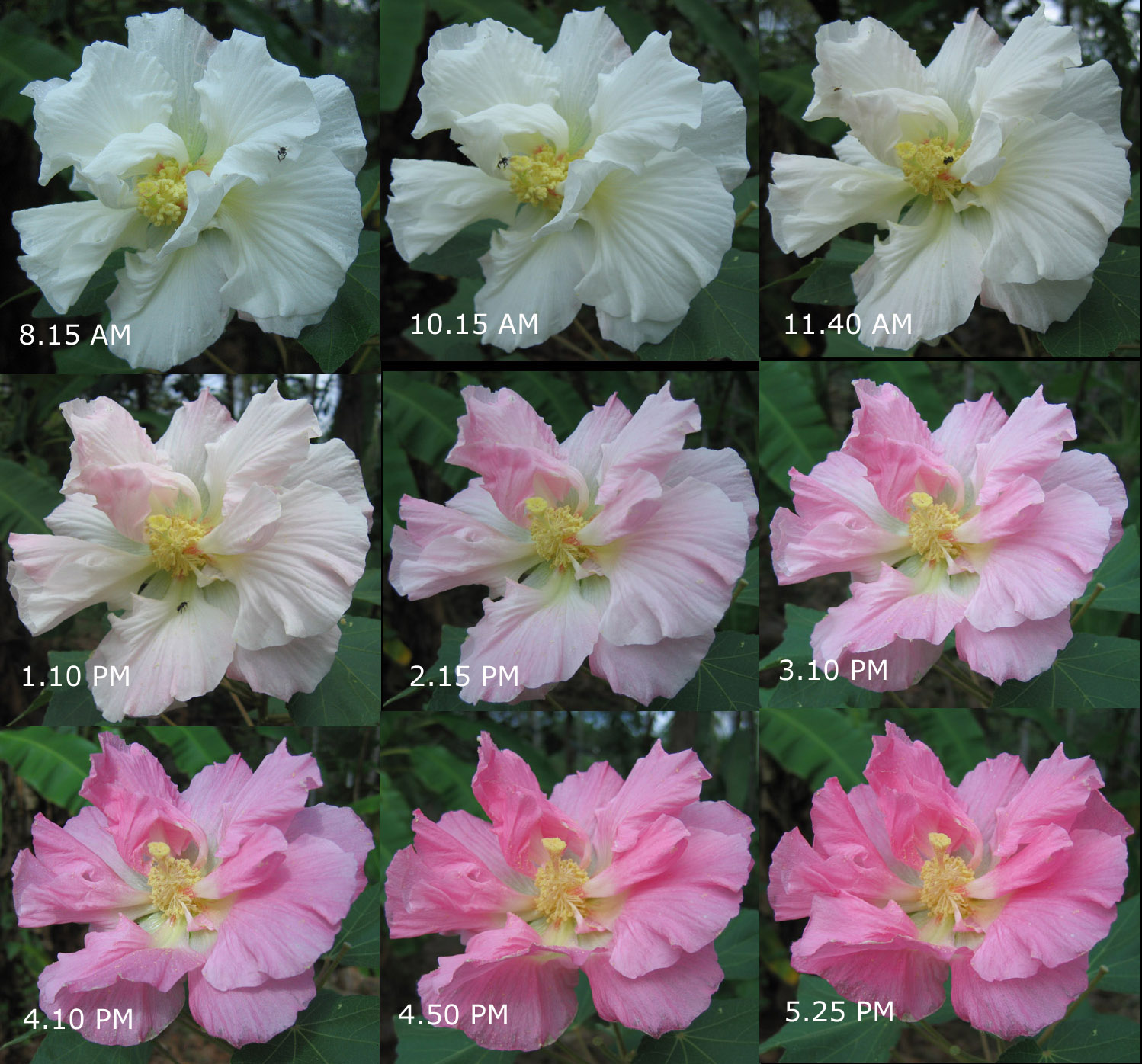
Confederate Rose – Hibiscus Mutablis
“Confederate Rose is a wonderful plant that is really unknown outside the Southeast, where it has been grown in landscapes for many — and I mean many — years.
“Confederate Rose is in its prime blooming season in late summer and fall, and these plants will produce literally hundreds of blooms per plant. As the older flowers start to fade, new ones open. On a typical day, there will be loads of flowers in varying shades of white, pink and dark pink. I love the 6-inch-diameter, double-form flowers
Image Credit: Gary Bachman – MSU Extension
“Confederate Rose produces hundreds of blooms per plant in its prime blooming season of late summer and fall. As the older flowers fade, new ones open.
Image Credit: Wikipedia
“When choosing a place for this plant in your landscape, first recognize that it needs full sun. Then consider the size of the plant, which is impressive at up to 10 feet tall or more. I think the best landscape use is as a specimen plant in order to properly display the gorgeous flowers, which bloom in prodigious numbers.
“Confederate rose likes a consistently moist planting bed, but it does not like wet feet. The leaves are large and frequently start to look a little wilty on hot summer days, but the plant bounces back the next morning when gardeners maintain consistent soil moisture.
“Typically, this plant dies back to the ground after a hard frost, although it may overwinter in the extreme coastal counties. But don’t worry. Confederate Rose will emerge from winter dormancy to shoot up 8 to 10 feet or more the next season. Cut back Confederate Rose to 4 to 6 inches in late winter to accommodate the next season’s growth, which springs up from the roots.
“The best time to take cuttings is in late fall, and here’s where the pass-along plant reference comes in.
“Collect cuttings about 12 inches long, and remove all but the two uppermost leaves. Place the stems in a glass jar of water, and put it on a warm and sunny windowsill, avoiding direct sunlight. If all goes as it should, in about eight weeks the stems will develop nice sets of roots. At this point, the new plants can be transplanted into larger containers.
“Keep your new plants in a sunny location indoors until later in the spring after all chance of frost has passed.” Gary Bachman, MSU Extension
“Confederate rose (Hibiscus mutabilis) seeds can germinate in as little as one day, and seedlings can flower in 5–6 weeks or up to a full season. With proper care, a confederate rose can grow into a 15-foot tall bush in a single season. However, the plant will usually die back to the ground in the winter, but it will typically sprout again from the crown in the spring.” Google ai
|
|

Hardy Hibiscus
(Including Confederate Rose, Hibiscus mutabilis)By Dr. William C. Welch
Professor and Landscape Horticulturist
Texas A&M University, College Station, Texas
The giant rose mallow has the largest flowers of any hardy perennial. Some of the hybrids may be one foot in diameter. Rich, moist soil and full sun bring the most vigorous growth, but mallows are very accommodating, and will tolerate light shade and less desirable soils. Giant rose mallows will flower from seed the first year if started very early in spring. Favorite cultivars may be rooted from cuttings during the growing season. Colors range from crimson, white, pink, rose, and in-between.Giant rose mallows are relatives of the native hibiscus found in Louisiana and other Gulf South states. They are among the most spectacular and easily grown plants for use in the border. Following the spring and summer growing season, the plants freeze back to the ground each fall. Old stems should be cut back to a height several inches above the ground. New shoots emerge by mid-spring, and the plants quickly develop handsome mounds of foliage and flowers by early summer. Individual flowers last only a day, but each plant may flaunt several flowers at once. Numerous seedling selections, such as Southern Belle’ and ‘Frisbee’ are offered in good seed catalogs. Few garden plants provide so much enjoyment for so little care.
Seeds of giant rose mallows are available from catalogs, while container-grown plants are usually in stock at Texas garden centers and nurseries. Color selection is possible when you purchase blooming-size plants. If growing giant rose mallows from seed, it is important to start them early in the season so that they will have adequate time to develop before freezing weather sets in.

Hibiscus mutabilis is an old-fashioned perennial or shrub hibiscus better known as the Confederate rose. It tends to be shrubby or treelike in Zones 9 and 10, though it behaves more like a perennial further north. Flowers are double and are 4 to 6 inches in diameter; they open white or pink, and change to deep red by evening. The ‘Rubra’ variety has red flowers. Bloom season usually lasts from summer through fall. Propagation by cuttings root easiest in early spring, but cuttings can be taken at almost any time. When it does not freeze, the Confederate rose can reach heights of 12 to 15 feet with a woody trunk; however, a multi-trunk bush 6 to 8 feet tall is more typical. Once a very common plant throughout the South, Confederate rose is an interesting and attractive plant that grows in full sun or partial shade, and prefers rich, well-drained soil.
|
Like this:
Like Loading...
Related
Discover more from Jacki Kellum
Subscribe to get the latest posts sent to your email.



